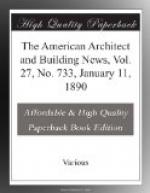* * * * *
According to the Wiener Bauindustrie Zeitung, the splendid Brunswick monument at Geneva is on the point of falling down. Every one remembers the history of this structure, which was erected in 1879, at a cost of six hundred thousand dollars, to the memory of Charles the Second of Brunswick, the “Diamond Duke,” as he was called by the Germans, who, after his expulsion from his principality by his subjects, on account of his extravagance and general worthlessness, took up his residence in Geneva, and, on his death, in 1873, bequeathed all his property, about four million dollars, to the city. The municipality was grateful enough to carry out in a very sumptuous manner the last wishes of its benefactor, who desired to be commemorated by a monument in the style of the later Scaliger tomb at Verona, and from the designs of Frauel was erected the hexagonal Gothic pavilion, surmounted by an equestrian statue of the Duke, which is so well known to architects. The Veronese prototype of the monument is a tolerably insecure affair, but the modern imitation is still larger and heavier, and two years after its completion the substructure began to come to pieces. It was then clamped with metal, but water got into the joints, and further repairs were soon necessary. In 1883, the Carrara marble of which it was built had so far decayed that the rebuilding of the whole with more durable stone was seriously proposed; and now, examination, having shown that the whole affair is likely to collapse at any moment, the city authorities have asked for authority to raise eight thousand dollars, by loan, to put it in secure condition. To tell the truth, it would not be an irreparable loss to the world to have the structure go to ruin. An imitation of an existing monument is not likely to be a very inspiring work of art, and this was not extremely successful, even as an imitation; while the historical fact which it immortalized, that the last representative of one of the six great German princely families, whose ancestors had been reigning sovereigns for a thousand years, had been obliged to set up the images of his haughty forefathers in a community of Republicans, because his own people despised and hated him so much that they could endure him no longer, was not of a character to arouse noble thoughts in the mind of the beholder.
* * * * *




